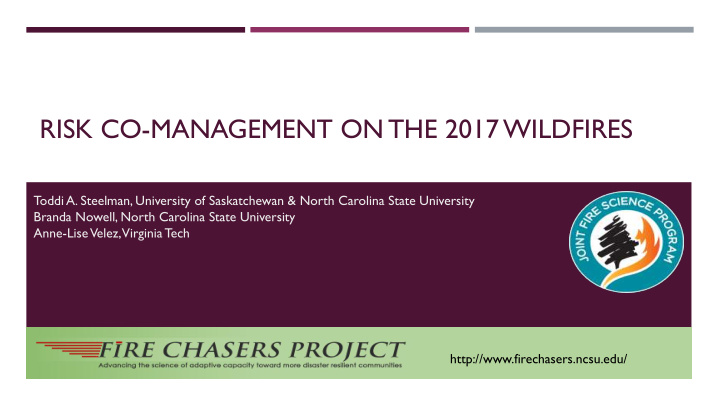



RISK CO-MANAGEMENT ON THE 2017 WILDFIRES Toddi A. Steelman, University of Saskatchewan & North Carolina State University Branda Nowell, North Carolina State University Anne-Lise Velez, Virginia Tech http://www.firechasers.ncsu.edu/
Cohesive Strategy Goals ● Fire Adapted Communities ● Safe and Effective Wildfire Response COHESIVE STRATEGY & WILDFIRE RESPONSE ● Resilient Landscapes Large wildfires ignore political & jurisdictional boundaries Rising expectations about who will be involved in wildfire response Growing recognition of the need for co-management practices Competing values, interests & priorities How do we reconcile differing and sometimes competing mission/needs? What are these differences? Where are they most prevalent?
10 MOST COMPLEX WILDFIRES IN US 2017 Most complex = multi-jurisdictional Federal, state, local and private interests Federal led fires, state led fires 6 states – 6 GACCs Preliminary evidence 6 wildfires to date 4 more to come Taken Sept. 5, 2011 in Bastrop, TX of the Bastrop Complex Fire. Credit: Michael Rose via Flickr.
10 ITEM SURVEY – CHARACTERISTICS OF WILDFIRE CO-MANAGEMENT 1. A coordinated set of fire management objectives were agreed upon among all affected jurisdictions 2. All concerned jurisdictions prioritized maintaining good communication among jurisdictions 3. Credit for success and effort was shared among jurisdictions during public meetings and media events 4. There was a general willingness across affected jurisdictions to offer assistance to other jurisdictions 5. “Borrowed resources” were released in a timely fashion to minimize burden on the lending agency 6. Critical values at risk were broadly understood by all major stakeholders 7. Efforts to protect identified values were appropriate given available resources 8. The overall strategy taken in managing this fire was appropriate 9. Local resources were incorporated into the incident management operations 10. Public information was coordinated among cooperating jurisdictions to ensure continuity of the message
SHARED PERSPECTIVES: WHAT DIMENSIONS OF CO-MANAGEMENT ARE WORKING? General agreement with no significant differences 3 among jurisdictions 2.5 2 1.5 1 0.5 0 All concerned jurisdictions prioritized maintaining good There was a general willingness across affected Credit for success and effort was shared among communication among jurisdictions (n=37) NS jurisdictions to offer assistance to other jurisdictions jurisdictions during public meetings and media events (n=37) NS (n=36) NS Federal Local State Private 1 = most agree, 5 = most disagree NS = no significant difference among jurisdictions
DIVERGENT PERSPECTIVES: WHERE DO WE NEED MORE WORK IN CO-MANAGEMENT? 4.5 Federal and local actors tend to agree; 4 Private and state actors tend to disagree 3.5 3 2.5 2 1.5 1 0.5 0 The overall strategy taken in managing this fire was Local resources were incorporated into the incident Critical values at risk were broadly understood by all appropriate (n=36) *** management operations (n=37) ** major stakeholders (n=37) ** Federal Local State Private 1 = most agree, 5 = most disagree Significant differences among jurisdictions: * = .10 to .05, ** = .05 to .01, *** = .01or lower
CONCLUSIONS AND IMPLICATIONS FOR COHESIVE STRATEGY Offering assistance, good communication, sharing credit for success Well practiced, more routine (mutual aid agreements, communication practices, pre-fire work) Appropriateness of strategy, incorporating local resources, understanding critical values at risk Reflection of shifting risk management strategies (Big box strategy, indirect vs. going more direct, aggressive) Divergent understanding and prioritization of risks (relative importance of commercial resource values i.e., timber, rangeland) “Feds will go protect houses but they won’t protect my investment in my timber, which is uninsured” “States will put fire fighters in places to protect timber and I do not want to take those risks” Different risk tolerance perceptions based on experience and location “I live here and fight this kind of fire every year. It is not a risk for me to go in there and do this” State and private most disagree Competing missions, multiple objectives (feds) vs. single objectives (state/private) State and private need to be more assertive about needs Feds need to be more aware of difference
THANK YOU! Questions? Funded by the Joint Fire Science Program. Grant number JFSP 17-1-06-14 L17AC00232. 2017
Recommend
More recommend